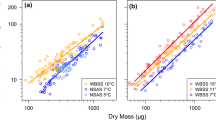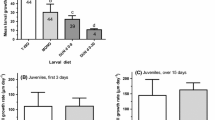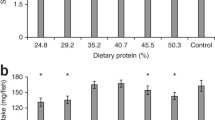Abstract
Diet has been linked to lifespan in a broad range of animals. In particular, pronounced caloric restriction has been associated with increased longevity. Herein, the relationship of feeding environment and longevity is examined experimentally using Spinicaudatan crustaceans (“clam shrimp”) from the geographically widespread genus Eulimnadia. Two projects examine the effects of food differences on longevity, one comparing food environment early vs later in life and one comparing the effects of dietary restriction on longevity, growth, and reproduction. In the former, dietary restriction increased longevity, but only when diets were reduced later in life. A closer examination of the effects of dietary restriction in the second experiment did not find the expected trade-off of increased longevity and reduced reproductive output in the lowest-food treatment, but instead found an overall increase in both longevity and egg production on the low compared to the high food diet. Finally, a detailed analysis of the relationship of size (carapace length) with egg production was presented. This relationship could serve to obtain a rough estimate of reproductive output potential of fossil clam shrimps, of which typically only the carapace size can be assessed.
Similar content being viewed by others
References
Astrop, T. I., V. Sahni, T. A. Blackledge & A. Y. Stark, 2015. Mechanical properties of the chitin-calcium-phosphate “clam shrimp” carapace (Branchiopoda: Spinicaudata): implications for taphonomy and fossilization. Journal of Crustacean Biology 35: 123–131.
Balasubramanian, P., P. R. Howell & R. M. Anderson, 2017. Aging and caloric restriction research: a biological perspective with translational potential. Ebiomedicine 21: 37–44.
Belk, D., 1972. The biology and ecology of Eulimnadia antlei Mackin (Conchostraca). Southwestern Naturalist 16: 297–305.
Brantner, J. S., D. W. Ott, R. J. Duff, J. I. Orridge, J. R. Waldman & S. C. Weeks, 2013a. Evidence of selfing hermaphroditism in the clam shrimp Cyzicus gynecia (Branchiopoda: Spinicaudata). Journal of Crustacean Biology 33: 184–190.
Brantner, J. S., D. W. Ott, R. J. Duff, L. O. Sanoamuang, G. P. Simhachalam, K. K. S. Babu & S. C. Weeks, 2013b. Androdioecy and hermaphroditism in five species of clam shrimps (Crustacea: Branchiopoda: Spinicaudata) from India and Thailand. Invertebrate Biology 132: 27–37.
Calabrese, A., C. McCulloch, B. Knott & S. C. Weeks, 2016. Environmental characteristics of ephemeral rock pools explain local abundances of the clam shrimp, Paralimnadia badia (Branchiopoda: Spinicaudata: Limnadiidae). Journal of the Royal Society of Western Australia 99: 9–15.
Chen, P.-J. & J. D. Hudson, 1991. The conchostracan fauna of the Great Estuarine Group, Middle Jurassic, Scotland. Palaeontology 34: 515–545.
Chen, P.-J. & Y. B. Shen, 1985. Fossil Conchostraca. Science Press, Beijing.
Clutton-Brock, T. & P. Langley, 1997. Persistent courtship reduces male and female longevity in captive tsetse flies Glossina morsitans morsitans Westwood (Diptera: Glossinidae). Behavioral Ecology 8: 392–395.
Comfort, A., 1979. The Biology of Senescence, 3rd ed. Churchill Livingston, Edinburgh.
Currie, J. J. & D. C. Schneider, 2011. Spatial scaling from latitudinal gradients: size-specific fecundity in the American lobster Homarus americanus. Marine Ecology Progress Series 439: 193–201.
Dumont, H. J. & S. V. Negrea, 2002. Introduction to the class Branchiopoda. Backhuys, Leiden.
Durga-Prasad, M. K. & G. Simhachalam, 2004. Eulimnadia indocylindrova n. sp. (Branchiopoda: Spinicaudata) from South India with a review of the genus Eulimnadia in Indomalayan region. Proceedings of the International Conference The Great Himalayas: Climate, Health, Ecology, Management, and Conservation.
Eder, E., S. Richter, R. Gottwald & W. Hodl, 2000. First record of Limnadia lenticularis males in Europe (Branchiopoda: Conchostraca). Journal of Crustacean Biology 20: 657–662.
Gallego, O. F. & C. Breitkreuz, 1994. Paleozoic Chonchostracans (Crustaceae-Conchostraca) from Antofagasta Region, Northern Chile. Revista Geologica De Chile 21: 31–53.
Gems, D. & D. L. Riddle, 2000. Defining wild-type life span in Caenorhabditis elegans. Journals of Gerontology Series a-Biological Sciences and Medical Sciences 55: B215–B219.
Geyer, G. & K. P. Kelber, 2018. Spinicaudata (“Conchostraca,” Crustacea) from the Middle Keuper (Upper Triassic) of the southern Germanic Basin, with a review of Carnian-Norian taxa and suggested biozones. Palz 92: 1–34.
Green, B. S., C. Gardner & R. B. Kennedy, 2009. Generalised linear modelling of fecundity at length in southern rock lobsters, Jasus edwardsii. Marine Biology 156: 1941–1947.
Gueriau, P., N. Rabet & E. D. T. Hat, 2018. The Strud crustacean fauna (Late Devonian, Belgium): updated review and palaeoecology of an early continental ecosystem. Earth and Environmental Science Transactions of the Royal Society of Edinburgh 107: 79–90.
Harper, J. L., 1977. The Population Biology of Plants. Academic Press, London/New York.
Hethke, M., F. T. Fursich, J. D. Morton & B. Y. Jiang, 2018. Analysis of morphological variability in the clam shrimp Eosestheria middendorfii (Crustacea, Spinicaudata) from the lower Cretaceous of China, and its implications for Spinicaudatan taxonomy. Papers in Palaeontology 4: 21–53.
Hethke, M., F. T. Fursich, B. Y. Jiang, B. Wang, P. Chellouche & S. C. Weeks, 2019. Ecological stasis in Spinicaudata (Crustacea, Branchiopoda)? Early Cretaceous clam shrimp of the Yixian Formation of north-east China occupied a broader realized ecological niche than extant members of the group. Palaeontology 62: 483–513.
Huang, W. P. & L. S. Chou, 2015. Temperature effect on development and reproduction of the androdioecious clam shrimp, Eulimnadia braueriana (Branchiopoda: Spinicaudata). Journal of Crustacean Biology 35: 330–338.
Huang, W. P. & L. S. Chou, 2017. Temperature effects on life history traits of two sympatric branchiopods from an ephemeral wetland. PLoS ONE 12: 18.
Johnson, T. E. & E. W. Hutchinson, 1993. Absence of strong heterosis for life-span and other life-history traits in Caenorhabditis elegans. Genetics 134: 465–474.
Kirkwood, T. B. L. & D. P. Shanley, 2005. Food restriction, evolution and ageing. Mechanisms of Ageing and Development 126: 1011–1016.
Knoll, L. & N. Zucker, 1995. Selfing versus outcrossing in the androdioecious clam shrimp, Eulimnadia texana (Crustacea, Conchostraca). Hydrobiologia 298: 83–86.
Kobayashi, T., 1954. Fossil Estherians and allied fossils. Journal of the Faculty of Science, University of Tokyo, section 2(9): 1–192.
Lemaitre, J. F., V. Berger, C. Bonenfant, M. Douhard, M. Gamelon, F. Plard & J. M. Gaillard, 2015. Early-late life trade-offs and the evolution of ageing in the wild. Proceedings of the Royal Society B-Biological Sciences 282: 10.
Li, G., 2017. Morphological restudy of the type species of Xibeiestheria (Spinicaudata) from the lower Aptian, northwestern China. Cretaceous Research 80: 31–37.
Mackin, J. G., 1940. A new species of conchostracan phyllopod, Eulimnadia antlei, from Oklahoma. American Midland Naturalist 23: 219–221.
Maeda-Martinez, A. M., 1991. Distribution of Species of Anostraca, Notostraca, Spinicaudata, and Laevicaudata in Mexico. Hydrobiologia 212: 209–219.
Martin, J. W., 1989. Eulimnadia belki, a new clam shrimp from Cozumel, Mexico (Conchostraca, Limnadiidae), with a review of central and South American species of the genus Eulimnadia. Journal of Crustacean Biology 9: 104–114.
Martin, J. W. & D. Belk, 1989. Eulimnadia ovilunata and Eulimnadia ovisimilis, New species of clam shrimps (Crustacea, Branchiopoda, Spinicaudata) from South America. Proceedings of the Biological Society of Washington 102: 894–900.
Masoro, E. J., 1988. Food restriction in rodents—an evaluation of its role in the study of aging. Journals of Gerontology 43: B59–B64.
Mattox, N. T., 1939. Description of two new species of the genus Eulimnadia and notes on the other Phyllopoda of Illinois. American Midland Naturalist 22: 642–653.
McCulloch, D. & D. Gems, 2003. Evolution of male longevity bias in nematodes. Aging Cell 2: 165–173.
Monferran, M. D., O. F. Gallego & N. G. Cabaleri, 2013. The first record of the family Fushunograptidae (‘Conchostraca’, Spinicaudata) from the Canadon Asfalto formation (upper Jurassic), Patagonia, Argentina. Ameghiniana 50: 447–459.
Morton, J. D., D. I. Whiteside, M. Hethke & M. J. Benton, 2017. Biostratigraphy and geometric morphometrics of conchostracans (Crustacea, Branchiopoda) from the Late Triassic fissure deposits of Cromhall Quarry, UK. Palaeontology 60: 349–374.
Olesen, J. & M. J. Grygier, 2003. Larval development of Japanese ‘conchostracans’: part 1, larval development of Eulimnadia braueriana (Crustacea, Branchiopoda, Spinicaudata, Limnadiidae) compared to that of other limnadiids. Acta Zoologica 84: 41–61.
Orr, P. J. & D. E. G. Briggs, 1999. Exceptionally preserved conchostracans and other crustaceans from the Upper Carboniferous of Ireland. Special Papers in Palaeontology Series 62: 5–68.
Orr, P. J., D. E. G. Briggs & S. L. Kearns, 2008. Taphonomy of exceptionally preserved crustaceans from the Upper Carboniferous of southeastern Ireland. Palaios 23: 298–312.
Padhye, S. M. & E. A. Lazo-Wasem, 2018. An updated and detailed taxonomical account of the large Branchiopoda (Crustacea: Branchiopoda: Anostraca, Notostraca, Spinicaudata) from the Yale North India Expedition deposited in the Yale Peabody Natural History Museum. Zootaxa 4394: 207–218.
Pereira, G. & J. V. Garcia, 2001. A review of the clam shrimp family Limnadiidae (Branchiopoda, Conchostraca) from Venezuela, with the description of a new species. Journal of Crustacean Biology 21: 640–652.
Perez-Bote, J. L., J. P. G. Piriz & A. G. Solis, 2014. Biological traits of Cyzicus grubei (Crustacea, Spinicaudata, Cyzicidae) in south-western Iberian Peninsula. Limnetica 33: 227–235.
Phelan, J. P. & M. R. Rose, 2005. Why dietary restriction substantially increases longevity in animal models but won’t in humans. Ageing Research Reviews 4: 339–350.
Reed, S. K., R. J. Duff & S. C. Weeks, 2015. A systematic study of the genus Eulimnadia. Journal of Crustacean Biology 35: 379–391.
Rogers, D. C., N. Rabet & S. C. Weeks, 2012. Revision of the extant genera of Limnadiidae (Branchiopoda: Spinicaudata). Journal of Crustacean Biology 32: 827–842.
Rose, M. R., 1991. Evolutionary Biology of Aging. Oxford University Press, New York.
Sassaman, C., 1989. Inbreeding and sex-ratio variation in female-biased populations of a clam shrimp, Eulimnadia texana. Bulletin of Marine Science 45: 425–432.
Sassaman, C., 1995. Sex determination and evolution of unisexuality in the Conchostraca. Hydrobiologia 298: 45–65.
Sassaman, C. & S. C. Weeks, 1993. The genetic mechanism of sex determination in the conchostracan shrimp Eulimnadia texana. American Naturalist 141: 314–328.
Schwentner, M., B. V. Timms, R. Bastrop & S. Richter, 2009. Phylogeny of Spinicaudata (Branchiopoda, Crustacea) based on three molecular markers—an Australian origin for Limnadopsis. Molecular Phylogenetics and Evolution 53: 716–725.
Shen, Y. B., 1994. Jurassic Conchostracans from Carapace Nunatak, Southern Victoria Land, Antarctica. Antarctic Science 6: 105–113.
Smith, D. G., 1992. A redescription of types of the clam shrimp Eulimnadia agassizii (Spinicaudata, Limnadiidae). Transactions of the American Microscopical Society 111: 223–228.
Tasch, P., 1971. Invertebrate fossil record and continental drift. In Quam, L. O. (ed) Research in the Antarctic. Vol. Pub. No. 93. American Association for the Advancement of Science, Washington: 703–716.
Tasch, P., 1987. Fossil Conchostraca of the southern hermisphere and continental drift. Paleontology, biostratigraphy, and dispersal, Memoir 165 edn. Geological Society of America, Boulder.
Tasch, P. & B. L. Shaffer, 1964. Conchostracans: living and fossil from Chihuahua and Sonora, Mexico. Science 143: 806–807.
Timms, B. V., 2016. A partial revision of the Australian Eulimnadia Packard, 1874 (Branchiopoda: Spinicaudata: Limnadiidae). Zootaxa 4066: 351–389.
Timms, B. V. & S. Richter, 2009. The clam shrimp Eocyzicus (Branchiopoda: Spinicaudata: Cyzicidae) in Australia. Journal of Crustacean Biology 29: 245–253.
Tinti, F. & F. Scanabissi, 1996. Reproduction and genetic variation in clam shrimps (Crustacea, Branchiopoda, Conchostraca). Canadian Journal of Zoology-Revue Canadienne De Zoologie 74: 824–832.
Tippelt, L. & M. Schwentner, 2018. Taxonomic assessment of Australian Eocyzicus species (Crustacea: Branchiopoda: Spinicaudata). Zootaxa 4410: 401–452.
Vannier, J., A. Thiery & P. R. Racheboeuf, 2003. Spinicaudatans and ostracods (Crustacea) from the Montceau Lagerstatte (Late Carboniferous, France): morphology and palaeoenvironmental significance. Palaeontology 46: 999–1030.
Vidrine, M. F., S. L. Sissom & R. E. McLaughlin, 1987. Eulimnadia texana Packard (Conchostraca, Limnadiidae) in rice fields in southwestern Louisiana. Southwestern Naturalist 32: 1–4.
Walossek, D., 1993. The Upper Cambrian Rehbachiella and the phylogeny of Branchiopoda and Crustaca. Fossils and Strata 32: 1–202.
Webb, J. A. & G. D. Bell, 1979. A new species of Limnadia (Crustacea: Conchostraca) from the granite belt in southern Queensland and Northern New South Wales. Proceedings of the Linnean Society of New South Wales 103: 237–246.
Weeks, S. C., 2004. Levels of inbreeding depression over seven generations of selfing in the androdioecious clam shrimp, Eulimnadia texana. Journal of Evolutionary Biology 17: 475–484.
Weeks, S. C., 2012. The role of androdioecy and gynodioecy in mediating evolutionary transitions between dioecy and hermaphroditism in the Animalia. Evolution 66: 3670–3686.
Weeks, S. C. & R. L. Bernhardt, 2004. Maintenance of androdioecy in the freshwater shrimp, Eulimnadia texana: field estimates of inbreeding depression and relative male survival. Evolutionary Ecology Research 6: 227–242.
Weeks, S. C. & N. Zucker, 1999. Rates of inbreeding in the androdioecious clam shrimp Eulimnadia texana. Canadian Journal of Zoology-Revue Canadienne De Zoologie 77: 1402–1408.
Weeks, S. C., V. Marcus & S. Alvarez, 1997. Notes on the life history of the clam shrimp, Eulimnadia texana. Hydrobiologia 359: 191–197.
Weeks, S. C., V. Marcus & B. R. Crosser, 1999. Inbreeding depression in a self-compatible, androdioecious crustacean, Eulimnadia texana. Evolution 53: 472–483.
Weeks, S. C., B. R. Crosser, R. Bennett, M. Gray & N. Zucker, 2000. Maintenance of androdioecy in the freshwater shrimp, Eulimnadia texana: estimates of inbreeding depression in two populations. Evolution 54: 878–887.
Weeks, S. C., J. A. Hutchison & N. Zucker, 2001. Maintenance of androdioecy in the freshwater shrimp, Eulimnadia texana: do hermaphrodites need males for complete fertilization? Evolutionary Ecology 15: 205–221.
Weeks, S. C., R. T. Posgai, M. Cesari & F. Scanabissi, 2005. Androdioecy inferred in the clam shrimp Eulimnadia agassizii (Spinicaudata: Limnadiidae). Journal of Crustacean Biology 25: 323–328.
Weeks, S. C., C. Benvenuto & S. K. Reed, 2006a. When males and hermaphrodites coexist: a review of androdioecy in animals. Integrative and Comparative Biology 46: 449–464.
Weeks, S. C., S. K. Reed, M. Cesari & F. Scanabissi, 2006b. Production of intersexes and the evolution of androdioecy in the clam shrimp Eulimnadia texana (Crustacea, Branchiopoda, Spinicaudata). Invertebrate Reproduction & Development 49: 113–119.
Weeks, S. C., T. F. Sanderson, M. Zofkova & B. Knott, 2008. Breeding systems in the clam shrimp family Limnadiidae (Branchiopoda, Spinicaudata). Invertebrate Biology 127: 336–349.
Weeks, S. C., E. G. Chapman, D. C. Rogers, D. M. Senyo & W. R. Hoeh, 2009. Evolutionary transitions among dioecy, androdioecy and hermaphroditism in limnadiid clam shrimp (Branchiopoda: Spinicaudata). Journal of Evolutionary Biology 22: 1781–1799.
Weeks, S. C., C. Benvenuto, T. F. Sanderson & R. J. Duff, 2010. Sex chromosome evolution in the clam shrimp, Eulimnadia texana. Journal of Evolutionary Biology 23: 1100–1106.
Weeks, S. C., J. S. Brantner, T. I. Astrop, D. W. Ott & N. Rabet, 2014b. The evolution of hermaphroditism from dioecy in crustaceans: selfing hermaphroditism described in a fourth Spinicaudatan genus. Evolutionary Biology 41: 251–261.
Weeks, S. C., C. Benvenuto, S. K. Reed, R. J. Duff, Z. H. Duan & P. David, 2014a. A field test of a model for the stability of androdioecy in the freshwater shrimp, Eulimnadia texana. Journal of Evolutionary Biology 27: 2080–2095.
Weindruch, R. & R. L. Walford, 1988. The retardation of aging and disease by dietary restriction. Charles C. Thomas, Springfield.
Weindruch, R., R. L. Walford, S. Fligiel & D. Guthrie, 1986. The retardation of aging in mice by dietary restriction—longevity, cancer, immunity and lifetime energy-intake. Journal of Nutrition 116: 641–654.
Zaffagnini, F., 1969. Rudimentary hermaphroditism and automictic parthenogenesis in Limnadia lenticularis (Phyllopoda, Conchostraca). Experientia 25: 650–651.
Zinn, D. J. & R. W. Dexter, 1962. Reappearance of Eulimnadia agassizii with notes on its biology and life history. Science 137: 676–677.
Zucker, N., M. Cunningham & H. P. Adams, 1997. Anatomical evidence for androdioecy in the clam shrimp Eulimnadia texana. Hydrobiologia 359: 171–175.
Zucker, N., B. Stafki & S. C. Weeks, 2001. Maintenance of androdioecy in the freshwater clam shrimp Eulimnadia texana: longevity of males relative to hermaphrodites. Canadian Journal of Zoology-Revue Canadienne De Zoologie 79: 393–401.
Acknowledgements
I thank Susan Wiedman and Kasey Yates for rearing help in the lab. All data generated or analyzed during this study are included in this published article [and its supplementary information files].
Author information
Authors and Affiliations
Corresponding author
Additional information
Handling editor: Dani Boix
Publisher's Note
Springer Nature remains neutral with regard to jurisdictional claims in published maps and institutional affiliations.
Rights and permissions
About this article
Cite this article
Weeks, S.C. Effects of dietary restriction on lifespan, growth, and reproduction of the clam shrimp Eulimnadia texana. Hydrobiologia 847, 3067–3076 (2020). https://doi.org/10.1007/s10750-020-04313-y
Received:
Revised:
Accepted:
Published:
Issue Date:
DOI: https://doi.org/10.1007/s10750-020-04313-y







